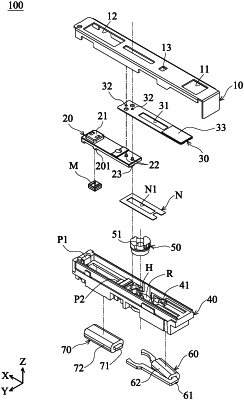| CPC H04N 23/57 (2023.01) [G02B 7/04 (2013.01); G03B 9/36 (2013.01); H04N 23/51 (2023.01); H04N 23/54 (2023.01); H04N 23/55 (2023.01); H10N 30/20 (2023.02)] | 18 Claims |

|
1. A driving mechanism for moving an optical element, comprising:
a base;
a movable unit, movably disposed on the base and connected to the optical element, wherein the movable unit has a first contact portion;
a movable part, movably disposed on the base and having a first restricting portion;
a first driving assembly, configured to force the movable part to move relative to the base between a first position and a second position; and
a second driving assembly, configured to force the movable unit to move relative to the base between a first limit position and a second limit position; and
a sheet yoke disposed in the base, wherein the second driving assembly is configured to impel the movable unit relative to the base in a horizontal direction, wherein when viewed in a vertical direction perpendicular to the horizontal direction, the sheet yoke and the first driving assembly at least partially overlap;
wherein when the movable unit is in an initial position, the first contact portion is engaged with the first restricting portion, thereby restricting the movable part in the first position;
wherein the movable unit further has a slider, and the movable part further has a longitudinal passage, wherein the first contact portion is formed on the slider, and when the movable part moves from the first position to the second position, the second driving assembly forces the slider to move through the passage.
|